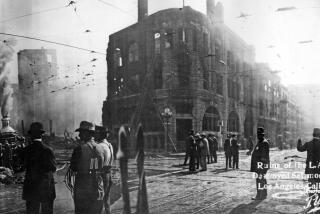Why Antilabor L.A. Embraced the Striking Janitors
Was this indeed the millennium?
Los Angeles, harsh company town with an antilabor reputation and a strike-busting, organization-killing old guard, opened its heart to a well-organized walkout of some of its lowest-paid workers seeking better pay. Motorists endured congestion and waved their fists, not in rage but in solidarity with thousands of marching, striking janitors in their shirts of bright red.
They won, with the help of a panoply of public support ranging from the driver in the street to Mayor Richard Riordan and Cardinal Roger M. Mahony. The janitors didn’t get all they asked for, but got a good part of it. They also won something for the hundreds of thousands of L.A. County workers like them: largely Spanish-speaking, often undocumented, frequently earning minimum wage or less. They won recognition for a body of labor previously taken for granted, people on whose availability and replaceability much of the region’s revived economy is based.
L.A. labor strife of recent decades has come in all sizes and flavors. There was the one-day job action of the Directors Guild of America in 1987, when strikers backed their Porsche Cabriolets into the DGA loading dock and filled them with picket signs. On the opposite end of the spectrum was the gravediggers’ campaign to organize a union, which Mahony himself blocked. In 1989, L.A. teachers struck and then sustained a loss of salary advances because of shrunken budgets. There was a huge walkout by telephone workers anticipating the baleful effects of technology on their employment, which came to pass regardless. And there was the first janitors’ action of 1990, in which gains were minimal and heads were beaten.
It was the era Mike Davis apostrophized in his 1990 “City of Quartz,” which described L.A. as a city that threw up barbed-wire-topped parapets between its high- and low-wage earners. Davis intimated that his Los Angeles would remain locked in this stasis, perpetuated by a stern downtown establishment and a pervasively antilabor and racist white middle class, for something like eternity.
What has happened since? How did most Angelenos, not to mention Mahony and moguls like Riordan and real-estate titan Rob Maguire, take the side of the downtrodden in a community not noted for supporting the underdog? According to County Federation of Labor organizing director Jon Barton, this is a major reversal. You might say it has to do with a flip-flop in class identification.
Class is who you identify with, and most L.A. residents had long identified themselves as the middle-class, white and home-owning norm. Thinking themselves above the laboring classes, they tended to identify and vote with the elites of the surrounding hillsides. But that was changing even as Davis wrote. Now it’s a truism that the middle class is no longer all white. But it’s also losing ground. Compared with 20 years ago, as the California Budget Project reported this month, average adjusted hourly wages were lower for the bottom 70% of California earners.
Everyone may not know how many executives make 400 times what their employees make, but most can feel the waxing disparity. This growing sense of inequity was perfectly symbolized by poor people getting peanuts to clean out the glassy towers of thriving commerce. “The janitors,” says Barton, “really pointed out the gap between the rich and the rest of us. . . .” The strike, Barton maintains, therefore caught the admiration of Angelenos.
But what difference will the janitors’ win make in the long run? Many newly unionized janitors, largely Latino, were brought in the ‘90s to replace higher-earning union janitors, mostly black. Could this cycle repeat itself, with more recent immigrants replacing Latinos? Organizers for the Service Employee International Union say “no,” that this is a tighter, more responsive union, founded on the zeal of a myriad young organizers, with better contracts. But such an anxiety may have prompted the union’s characterization of the final agreement as a win for both sides.
The local left has enthused that the strike’s success opens a new era of labor. Barton, however, cautions that such an era won’t come easily. In the first place, 300,000 union employees across the county have contract renewals coming due this year. Most are public employees, but 55,000 are members of the Screen Actors Guild and the American Federation of Television and Radio Artists. Will they reap the sympathy the janitors did? Or will county clerical workers, who want an increase from their current $15 an hour? This is already a a dream wage for most janitors, but it’s still below what the budget project says is needed to keep a single parent with children out of poverty.
Barton thinks the public may keep backing the workers, simply because income disparities are huge and widening and because so many people feel the money to remedy the inequity is there, somewhere, in the booming state and local economy. Ironically, many may believe this on the basis of Libertarian economics, which declares a rising tide lifts all boats. Or that it should.
“Stay away from the idea that our sole focus is on the poorest,” Barton advises. “We want to keep and grow a middle class.” Yet, it is the poorest-paid workers who most need union organization. The 700,000 union workers in a Los Angeles County of nearly 10 million inhabitants remain a small percentage of the work force. Barton says that to grow in an era of decreasing union membership, the county’s unions must vigorously increase their recruiting across the job landscape. Organizers like those who coalesced the hotel workers and janitors must reach ever deeper into the ranks of the hard-working low-waged.
When they do, expect many more underpaid workers out there in the streets, asking the rest of us to support them in their demands for better wages and benefits from the rich. *
More to Read
Sign up for Essential California
The most important California stories and recommendations in your inbox every morning.
You may occasionally receive promotional content from the Los Angeles Times.









